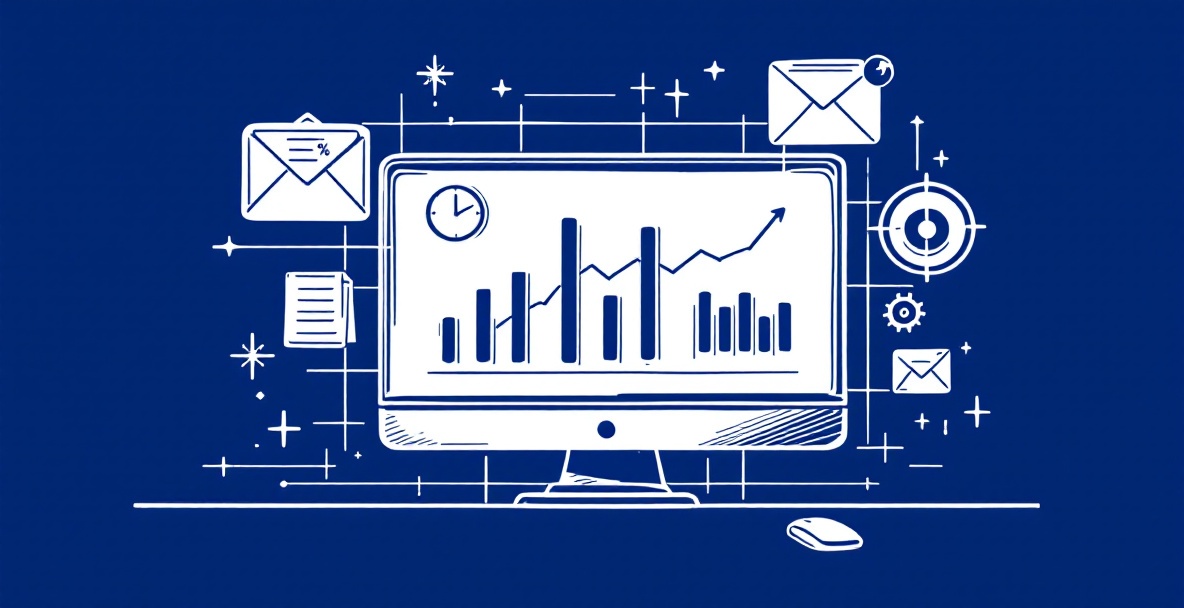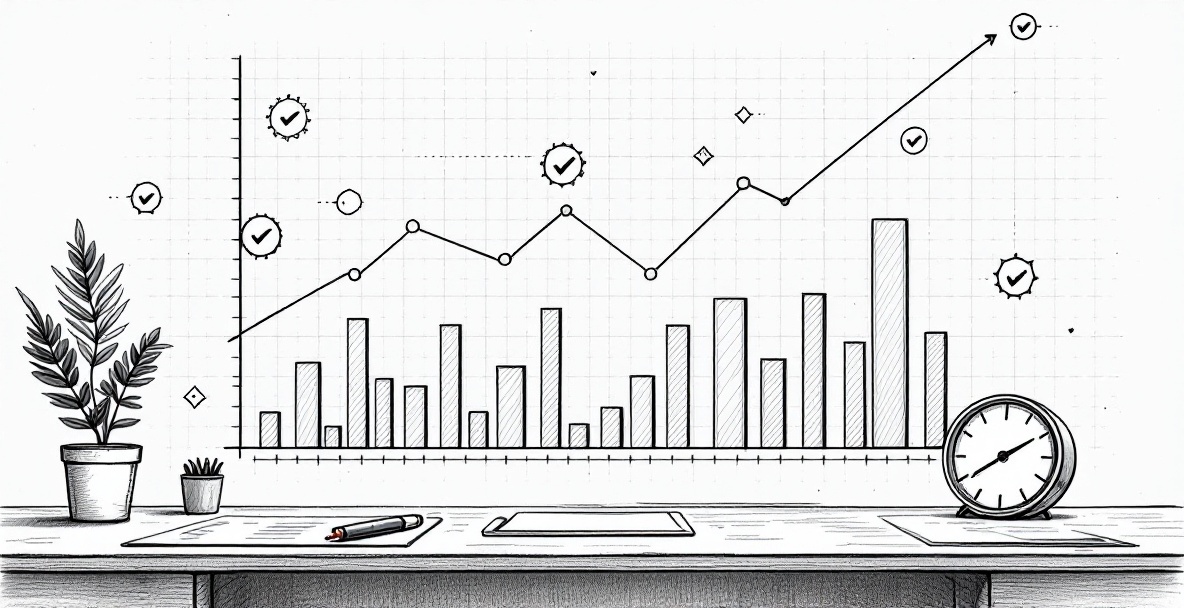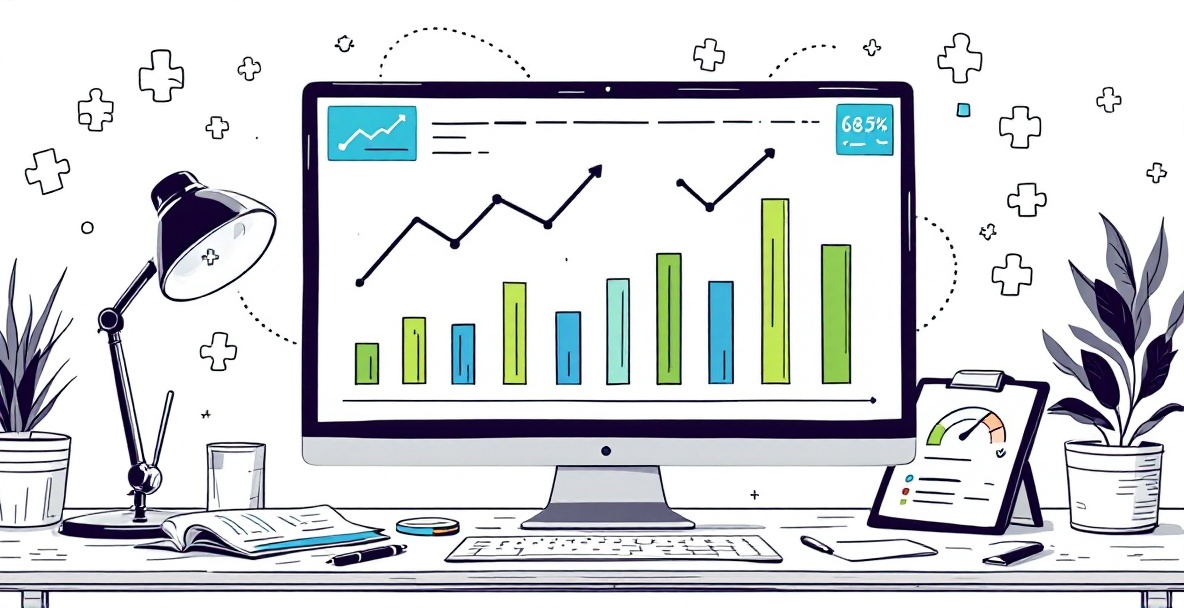Email marketing remains one of the most powerful tools in a digital marketer's arsenal, delivering an impressive $36 for every $1 spent according to recent industry data. But how do you know if your campaigns are truly performing well? Understanding email conversion benchmarks isn't just about comparing numbers—it's about gaining actionable insights that drive strategic decisions. At SEO Tuts, we've analyzed thousands of email campaigns across industries to help you set realistic targets and optimize your email marketing performance.
Understanding Email Marketing Success Metrics

The foundation of any successful email marketing strategy lies in understanding what metrics matter and how they work together to paint a complete picture of performance. While open rates receive considerable attention, conversion rates often provide a more accurate measure of campaign effectiveness and ROI potential.
Defining Conversion Rate in Email Marketing
Email conversion rate represents the percentage of email recipients who complete a desired action after clicking through your email. This action might involve making a purchase, filling out a form, downloading content, or any other goal-completion activity you've defined. The formula is straightforward: divide the number of conversions by the number of delivered emails, then multiply by 100.
Conversion rates differ significantly from click-through rates (CTRs), which simply measure the percentage of recipients who clicked a link in your email. The distinction is crucial—clicks indicate interest, but conversions demonstrate action. While industry averages hover between 1% and 5% for conversion rates, these numbers can vary dramatically based on factors including your industry, audience segments, offer type, and campaign objectives.
For instance, a well-crafted product recommendation email might achieve a 2-3% conversion rate, while a targeted cart abandonment sequence could reach 10-15% conversion rates. Understanding these nuances helps you establish appropriate benchmarks for different campaign types rather than applying a single standard across all your email marketing efforts.
Key Performance Indicators Beyond Conversion
While conversion rate provides valuable insight into campaign effectiveness, a comprehensive email marketing analysis must incorporate multiple metrics to provide context and identify optimization opportunities.
Open rate serves as an essential top-of-funnel metric, indicating how many recipients actually see your content. Recent privacy changes like Apple's Mail Privacy Protection have complicated open rate tracking, but comparative analysis remains useful for testing subject lines and sender information. Current benchmarks suggest healthy open rates between 15-25% for most industries.
Click-through rate (CTR) connects open rates to conversion rates, revealing how compelling your email content is at driving action. Average CTRs range from 2-5%, with significant variations by industry and email type. A high open rate paired with a low CTR suggests your content isn't delivering on the promise of your subject line.
Revenue per email (RPE) offers perhaps the most direct connection to business impact, calculating the average revenue generated by each email sent. This metric proves particularly valuable for e-commerce businesses or subscription-based services tracking direct sales from email campaigns.
List growth rate and unsubscribe rate provide critical insights into audience health and engagement sustainability. A healthy email list typically experiences 1-2% monthly growth while maintaining unsubscribe rates below 0.5% per campaign. Excessive unsubscribes often signal content relevance problems or frequency issues that require immediate attention.
Industry Benchmarks and Performance Standards

Setting realistic expectations requires understanding how email performance varies across different contexts. The benchmarks that apply to a B2B software company differ significantly from those relevant to e-commerce fashion retailers or nonprofit organizations.
B2B vs B2C Email Marketing Benchmarks
B2B and B2C email marketing operate with fundamentally different dynamics that impact conversion metrics. B2B email campaigns typically target longer sales cycles with multiple decision-makers, resulting in different performance patterns than direct-to-consumer communications.
B2B email marketing generally produces lower conversion rates (1-3% on average) compared to B2C campaigns (2-5% average), but these conversions often carry substantially higher value. The extended consideration phase in B2B purchasing means email nurture sequences might require 6-12 touchpoints before conversion, compared to 1-3 emails in many B2C contexts.
Content preferences also diverge significantly between these audiences. B2B recipients typically respond better to educational content, industry insights, and solution-focused messaging, with case studies and white papers driving particularly strong engagement. B2C audiences generally show higher response rates to promotions, limited-time offers, and product recommendations.
Response timing patterns differ as well. B2B emails typically perform best during business hours (Tuesday through Thursday), while B2C campaigns often generate stronger results during evenings and weekends when consumers have more personal time available.
Industry-Specific Performance Metrics
Industry context dramatically impacts what constitutes "good" email marketing performance. Our analysis at SEO Tuts reveals substantial variations in benchmark conversion rates across sectors:
Retail and e-commerce emails typically achieve conversion rates between 2-5%, with significant seasonal fluctuations. Product recommendation emails based on previous purchases often outperform general promotional content by 30-50%.
Financial services communications tend to see lower conversion rates (1-3%) but higher average order values, with educational content about financial planning and investment options generating the strongest engagement and trust-building.
Software and technology companies generally experience conversion rates between 2-4% for free trials and demonstrations, with significantly higher rates for existing customer communications like feature announcements and upgrade offers.
Healthcare and wellness businesses average 2.5-4.5% conversion rates, with preventive care reminders and personalized health recommendations producing the strongest response rates among engaged subscribers.
Travel and hospitality emails show some of the widest performance variations, from 1% conversions for general destination marketing to 10-15% for limited-time offers targeted to previous guests based on their travel history and preferences.
Geographic and Seasonal Variations
Email performance varies significantly across regions and seasons, requiring adjusted expectations and strategies. European markets typically show lower but more consistent conversion rates compared to North American campaigns, partly due to stricter privacy regulations and consent requirements.
Email engagement patterns in Asia-Pacific regions often favor mobile optimization, with over 70% of email opens occurring on smartphones compared to roughly 50% in Western markets. This regional difference significantly impacts conversion rate potential based on mobile experience quality.
Seasonal factors create predictable performance fluctuations across most industries. Retail email conversion rates typically increase by 25-40% during November-December holiday periods but require much stronger offers during January-February to maintain average performance levels. Travel sector emails show similar seasonal patterns but shifted to booking windows 3-6 months before peak travel seasons.
B2B email performance tends to decline significantly during July-August and December-January holiday periods, making campaign timing a critical consideration for meeting performance targets.
Optimization Strategies for Higher Conversion Rates

Understanding benchmarks provides context, but improving your conversion rates requires strategic action. The most effective optimization approaches focus on relevance, timing, and seamless user experience from email to conversion point.
List Segmentation and Personalization
Targeted messaging consistently outperforms generic broadcasts, with segmented campaigns generating 30-50% higher conversion rates than undifferentiated email blasts. Effective segmentation strategies include:
Behavioral segmentation based on past interactions with your emails, website, or products creates highly relevant targeting opportunities. Recipients who recently viewed specific products but didn't purchase convert at 3-5 times the rate of general list subscribers when sent abandoned browse reminders.
Demographic and firmographic data allows for contextually appropriate messaging that addresses specific challenges and opportunities. For B2B campaigns, company size, industry, and role-based segmentation can double conversion rates compared to general messaging.
Purchase history provides powerful indicators of interest and timing. Customers approaching typical replenishment cycles for consumable products show conversion rates 4-6 times higher than list averages when sent appropriately timed replenishment reminders.
Personalization extends beyond simply including the recipient's name. Advanced personalization incorporating browsing behavior, purchase history, and preference data can improve conversion rates by 25-35% compared to basic personalization approaches.
Dynamic content that automatically adjusts based on recipient characteristics allows single campaigns to deliver multiple tailored experiences. Implementation of dynamic content blocks typically improves conversion rates by 15-25% by increasing relevance without requiring separate campaign creation.
Landing Page and Email Design Integration
Conversion optimization requires seamless continuity between email promises and landing page experiences. Visual and messaging consistency between email and landing pages typically improves conversion rates by 15-30% by maintaining trust and momentum through the conversion process.
Mobile responsiveness becomes increasingly critical with over 60% of emails now opened on mobile devices. Campaigns with fully responsive design from email through checkout process convert at 2-3 times the rate of non-optimized experiences on mobile devices.
Focused landing pages that eliminate navigation options and concentrate on a single conversion action typically outperform general website pages by 30-50% for email traffic. This conversion-centered design approach reduces distractions and maintains the visitor's attention on completing the desired action.
Page load speed significantly impacts email marketing ROI, with each second of landing page load time reducing conversion rates by approximately 7%. Email campaigns driving traffic to pages loading in under two seconds typically achieve 25% higher conversion rates than those linking to slower-loading destinations.
Message match—ensuring headlines and offers on landing pages exactly mirror email promises—builds trust and reduces confusion. Strong message match implementation can improve conversion rates by 15-25% by confirming to visitors they've reached the correct destination.
Marketing Automation and Workflow Optimization
Strategic automation creates timely, relevant messaging that significantly outperforms scheduled broadcasts. Behavior-triggered emails respond to specific user actions with contextually appropriate messaging, generating 3-5 times higher conversion rates than standard promotional emails.
Event-based triggers like cart abandonment, product page views, and subscription milestone anniversaries create high-relevance opportunities for personalized communication. Cart abandonment sequences typically recover 10-15% of otherwise lost sales when implemented effectively.
Multi-stage nurture sequences that progressively educate prospects and move them toward conversion decisions produce 2-3 times higher ultimate conversion rates compared to single email approaches. These sequences perform particularly well for complex purchases requiring significant consideration.
Testing automation timing creates significant optimization opportunities. The optimal delay between trigger event and email delivery varies dramatically by context—from minutes for cart abandonment to days for post-purchase educational content—and can impact conversion rates by 15-30%.
Workflow branch logic that adapts subsequent messages based on recipient actions with previous emails allows for increasingly personalized experiences. Implementations with effective branch logic typically improve sequence conversion rates by 25-40% compared to linear sequences sending the same content to all recipients.
Measuring and Tracking Success

Effective measurement enables continuous optimization and accurate assessment of campaign performance against relevant benchmarks.
Analytics Setup and Reporting
Comprehensive analytics tracking requires proper integration between email platforms, website analytics, and conversion tracking systems. UTM parameters consistently applied to email links enable accurate attribution of conversions and revenue to specific campaigns, subject lines, and content elements.
Multi-touch attribution models provide more accurate perspectives on email's contribution to conversions than last-click approaches, particularly for longer consideration cycles. Advanced attribution analysis typically reveals email marketing's contribution to conversion is 20-40% higher than indicated by simpler models.
Regular reporting cadences with standardized metrics enable meaningful trend analysis and performance assessment. Weekly operational reporting combined with monthly strategic analysis typically provides the optimal balance between timely tactical insights and meaningful pattern recognition.
Custom dashboards that align email performance with specific business objectives create clarity and focus improvement efforts. These dashboards should prioritize outcome metrics (conversions, revenue) over activity metrics (sends, opens) to maintain business alignment.
A/B Testing Methodologies
Systematic testing drives continuous improvement in email marketing performance. Subject line testing typically yields the fastest performance gains, with 25-35% differences in open rates between winning and losing variations in well-designed tests.
Call-to-action testing examining button copy, design, and placement often reveals 10-20% conversion rate differences between variations, making it a high-return testing opportunity.
Send time optimization through systematic testing can improve open and conversion rates by 5-15% by aligning delivery with recipient availability and engagement patterns. These patterns vary significantly by audience and require direct testing rather than relying on industry generalizations.
Email design and layout testing requires larger sample sizes but can identify major performance improvement opportunities. Full-template tests comparing significantly different approaches typically reveal 15-25% performance differences in conversion rates between design philosophies.
Offer testing comparing different value propositions, incentive structures, or pricing approaches often produces the largest conversion rate variations, sometimes exceeding 50-100% differences between winning and losing offers. This makes offer testing particularly valuable despite the operational complexity often involved.
ROI Calculation and Performance Analysis
Accurate ROI assessment requires comprehensive cost and revenue tracking. Direct revenue attribution represents the most straightforward ROI component but often understates email's full value by missing contribution to offline conversions and multi-touch purchase journeys.
Customer lifetime value (CLV) impact provides a more complete perspective on email marketing's business contribution. Email-engaged customers typically show 30-50% higher retention rates and 20-40% higher lifetime value than non-engaged customers, making retention metrics essential for comprehensive performance analysis.
Cost-per-conversion calculations that include all program costs (platform, design, copywriting, strategy, etc.) provide realistic efficiency metrics for comparison against other channels. Mature email marketing programs typically achieve cost-per-conversion rates 25-50% lower than paid social or search campaigns targeting similar audiences.
Cohort analysis examining how conversion rates change over subscriber lifecycle stages reveals valuable optimization opportunities. New subscribers typically show different conversion patterns than established subscribers, with engagement often peaking in months 2-4 after subscription before gradually declining without specific retention strategies.
Next Steps and Implementation Guide
Improving your email marketing conversion rates requires both strategic vision and tactical execution. The following framework helps prioritize your optimization efforts for maximum impact.
Quick Wins and Long-term Strategies
Begin with high-impact, low-resource optimizations to build momentum. Segmenting your existing list based on recent engagement levels (active, lapsed, inactive) and creating targeted reengagement campaigns for lapsed subscribers can improve overall conversion rates by 10-15% within 30-60 days.
Subject line optimization through systematic A/B testing typically yields 5-10% performance improvements within the first month of implementation, making it an ideal starting point for testing programs.
Implement abandoned cart and browse reminder workflows to capture high-intent opportunities. These automated sequences typically recover 5-15% of otherwise lost conversions with minimal ongoing resource requirements after initial setup.
Long-term strategic initiatives should focus on building comprehensive customer journeys. Develop automated welcome sequences introducing new subscribers to your value proposition through 3-5 emails over their first 2-3 weeks. Well-crafted welcome sequences typically increase first-90-day conversion rates by 25-40% compared to single welcome emails.
Progressive profiling that gradually collects additional subscriber data enables increasingly personalized communications. Implementing preference centers and strategic profile enhancement questions within email content typically improves long-term conversion rates by 15-25% through improved relevance.
Resource Planning and Tool Selection
Effective email marketing requires appropriate technologies and skills aligned with your objectives. Essential platform capabilities include:
- Strong segmentation capabilities supporting behavioral, demographic, and engagement-based targeting
- Automation workflows with conditional logic based on subscriber actions
- Testing frameworks that support systematic optimization
- Analytics integration with your website and e-commerce platforms
- Personalization capabilities beyond basic merge fields
Resource allocation should prioritize strategic planning and analysis over pure production activities. Organizations achieving the highest email marketing ROI typically allocate 30-40% of program resources to strategy, testing, and analysis rather than focusing exclusively on creative production and deployment.
Skills development should emphasize analytical capabilities alongside creative expertise. Conversion optimization increasingly relies on data-driven decision making, making analytical skills as important as traditional copywriting and design skills for email marketing success.
Email marketing continues to evolve rapidly with changing privacy regulations, technological capabilities, and consumer expectations. Staying current with industry developments through continuous learning ensures your conversion rate benchmarks and strategies remain relevant in a changing landscape.
Ready to transform your email marketing performance with data-driven strategies and technical expertise? Visit SEO Tuts today to access our comprehensive guide library, interactive worksheets, and personalized coaching programs designed to help you master email marketing optimization and achieve industry-leading conversion rates.
Leave a Reply